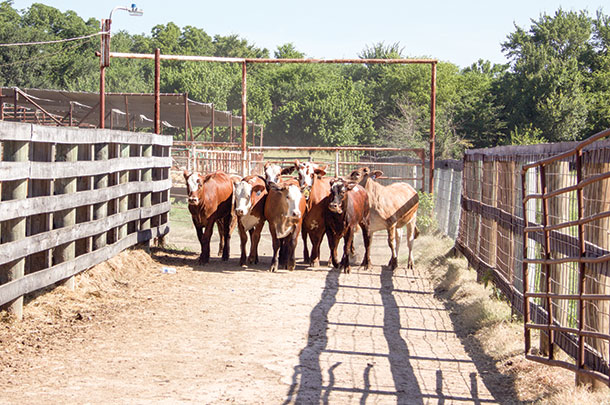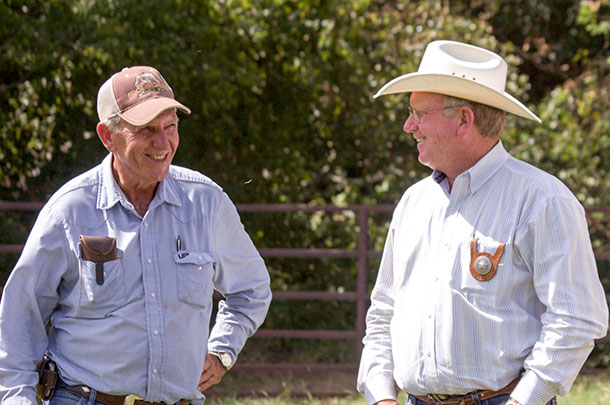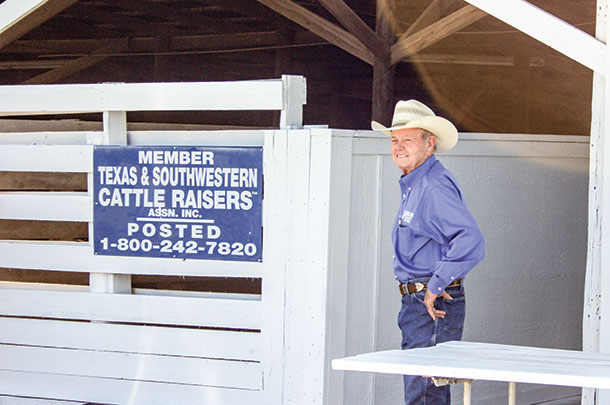Lost in the haze of nightfall, a truckload of stolen heifers – and thousands of dollars – easily slips away unnoticed.
High beef prices have marked cattle as an easy way to make money, and thieves are not ignoring the opportunity; cattle rustling is no longer a crime of the past.
The Texas and Southwestern Cattle Raisers Association (TSCRA) special rangers work diligently “to honor and protect the ranching way of life” by hunting down cattle rustlers and bringing justice to ranchers across Texas and Oklahoma. TSCRA employs 30 special rangers whose sole purpose is to investigate cattle thefts. In 2014, the rangers recovered approximately 4,000 head of cattle – a value of nearly $4.5 million.
The association was organized in 1877 when 40 cattlemen lost their cattle to thieves and decided to join together and protect their lifestyle. Now 138 years later, the TSCRA’s special rangers have been commissioned by the Texas Rangers as peace officers and prove effective as a law enforcement entity.
The rangers also investigate other agriculture-related thefts such as horses, trailers and other farm equipment. In total, more than $5 million in stolen property was recovered in 2014. On average, the rangers work 800 to 1,300 cases a year.
See more photos in this slideshow.
A well-oiled law enforcement machine
On any given day, Special Ranger Toney Hurley can be seen wearing his TSCRA badge just above his shirt pocket and a .45 caliber on his right hip as he visits sale barns and eats lunch at the local café. The sight of Hurley’s cattle brand and the ranger badge engraved into the sidearm’s ivory grip reveals he is a special ranger and a Texas peace officer.
After 22 years as a sheriff’s deputy and investigator for Texas’ Hopkins County, Hurley now focuses all of his time on the cattle industry – an industry he is passionate about. He joined the special rangers in 2012 and now watches over 11 counties in the northeast corner of Texas.
“You still get to put the bad guys in jail, but it’s just a different element,” Hurley says. “You get to deal with the agriculture end of law enforcement.”
Special rangers focus all of their time and energy on the agriculture industry, making them a unique branch of law enforcement. The 30 rangers have their own set of counties (districts) to oversee across Texas and Oklahoma. They also have a presence at the 115 Texas livestock markets to help stop any fraudulent activity.
TSCRA Executive Director of Law Enforcement and Theft Prevention Services Larry Gray says the association only hires applicants with extensive knowledge of the cattle industry and with previous experience in law enforcement. According to Gray, most of his special rangers grew up on ranches and gained investigative experience working for sheriff departments.
Hurley, along with most of the other special rangers, spends a lot of time working with the local sheriff’s department. They allow him to use their interrogation and holding facilities.
“We consider him as one of our investigators,” says Lewis Tatum, chief investigator for the Hopkins County Sheriff’s Department. “We don’t look at him as a private entity; even though he is a cattle ranger, he is on our side and he stands with us.”
Because special rangers are commissioned by the Texas Rangers and have the same authority as any other law enforcement branch, they can execute warrants and arrest people on-site.
After Hurley arrests a cattle rustler, he works with the district attorney to prosecute the thief. Just like a traditional law enforcement case, the thief is incarcerated with bail. Hurley has attended multiple court hearings, testified against defendants and supplied evidence to complete the prosecution. Depending on how many head of cattle are stolen, the crime can range from a misdemeanor or a felony.
“When cattle rangers win, we all win,” says Texas Ranger John Vance, who works a lot with Hurley. “We carry their commission because they are doing what we used to do; they are carrying that tradition on.”
Using forensic science to catch thieves
Cattle that are not branded make it extremely difficult for the special rangers to identify and recover them – but that doesn’t mean they don’t try.
On a day last year, Hurley received a call from a confidential informant and was given a tip there may be some stolen cattle being sold in Hugo, Oklahoma, that afternoon. Hurley hopped in the truck, drove to Hugo and made it just in time to watch the cattle go through the auction.
He pulled out his cellphone and snapped a couple photos of the cattle to later show the victim. Once the victim made a positive I.D., Hurley knew he had to prove ownership – but without a brand. Fortunately, Hurley searched the sale barn records and discovered he knew the person who purchased some of the stolen cattle.
Joe Don Pogue, owner and auctioneer of the Sulphur Springs Livestock and Dairy Auction, unknowingly bought some stolen cattle from a sale barn in Oklahoma. He had no idea stolen cattle were in his possession until Hurley visited his operation looking for a motley-faced steer with an ear notch – and there it was in the herd.
“The suspect told me to prove it,” Hurley says. “So I did.”
After Pogue found out the cattle were stolen, he did everything he could to help Hurley. They were able to pen the motley-faced steer and pull a few tail hairs. Hurley then took the tail hairs and sent them off for DNA testing with the tail hairs of 21 different herd bulls. When the tests came back with a 99.9 percent positive match, Hurley knew he could now prove ownership and recover the stolen cattle.
“Something like that has come a long way,” Pogue says. “Now the rangers have other ways of tracking cattle down besides a brand because if someone reports cattle that are missing and not branded – it makes their job pretty hard.”
Pogue returned the steer to the owner, and the thief was required to pay restitution to Pogue. But in many cases, according to Hurley, the thief goes to jail and very little restitution is paid; cattle producers are forced to bite that expense.
Hurley says DNA testing is used more often than not, and it is really handy when looking for hard evidence. The rangers also use science to match cut padlocks to the bolt cutters that cut them, and they are able to take fingerprints at the scene.
“I think Toney’s knowledge of what goes on in and out of the cattle business makes a difference rather than going to a sheriff’s department,” Pogue says. “Sheriffs know how to enforce the law – but not much experience in the cattle business.”
The lasting power of the brand
“A lot of the problems in northeast Texas come from not branding,” says Special Ranger Troy McKinney, the ranger for the Dallas-Fort Worth area. McKinney was a sheriff’s deputy before he joined the association in 1997 as a special ranger. “No brands make it pretty inviting for thieves to steal something.”
As a state law, Texas producers are not required to brand their cattle, but they can voluntarily register a brand in their county. McKinney says because it can be a hassle to arrange the time and facilities to brand, it’s easier for the small, part-time producers to not do it.
“In my area of Texas, there are more non-branded cattle than there are branded cattle,” McKinney says. “If a cow is not branded, the only other way to find out if it is the victim’s cow is if he still has the same bull it was bred from for a DNA test.”
To aid the special rangers, TSCRA has assigned market inspectors to be present at all of the livestock sale barns in Texas. The inspectors attend every sale and document all cattle unloaded for the auction. Any brands or identifying marks on cattle, along with the number of head, are recorded as well as the consignor’s name, physical description and license plate number.
The market inspectors send the documents and records to TSCRA headquarters where they are inputted into a database the rangers refer to when searching for cattle.
To make the database easy to navigate, every recorded brand is drawn on paper, scanned into the database and coded with an 11-digit number based on where the brand is positioned, letter of the alphabet used and the shape, etc. According to Gray, the association inspects 3 million to 5 million cattle a year.
“If you brand your cattle, the odds of us getting those cattle back double,” says Special Ranger Jimmy Dickson, the special ranger for the east. “There is no disputing what you’re after.”
McKinney and Hurley recently investigated a case near Greenville, Texas, that involved six victims and stretched across both their districts. It was a two-man job – one man stealing cattle and the other man buying them for cheap and raising them as his own.
“With his knowledge of the industry, he knew that there are a lot of cattle not branded,” McKinney says about the thief. “He buys these stolen cattle, takes them to a leased pasture, puts his brand on them and then sells the calves.”
If anyone were to question the thief about his ownership of the cattle, he would just take the stolen cows to the sale after the brand healed up and everything looked normal, McKinney says.
“You can’t question if he owns the cow because it’s wearing his brand,” McKinney says. “This guy knew how to work the system.”
The rangers were finally able to put a stop to the operation when Hurley caught the thieves in the act of stealing more cattle. The man who was stealing the cattle was using a stolen trailer.
Hurley gained permission from the trailer’s original owner to place a GPS tracker on it. Hurley was alerted when the trailer moved, tracked it down and witnessed the suspects loading it with more stolen cattle.
“Branding is the old-fashioned way,” Hurley says, “but it’s the best way.”
The best practices for theft prevention
Cut locks, damaged fences, a few head missing or a new bull visiting the heifers – call the area special ranger.
“We don’t mind you calling back a few days later and saying you found the cattle because they were just out,” Dickson says. “It just helps us get a head start.”
Hurley says there is nothing worse than jumping on a cold trail because a rancher waited three months to finally report the missing cattle.
“We work and solve our cases based on what the victim tells us,” McKinney says. “If they made someone mad and they fired them or any suspect information that can help us start working the case.”
Jerry Stone, a rancher near Athens, Texas, learned his lesson in the early 1980s when he had 20 weaned calves stolen from a lone corral far from town. They were gone for about six weeks until the special rangers recovered them all. Stone will never wean calves in an isolated area again.
The calves were found 30 miles away in a different county. Producers like Stone, who have cattle stretched across different counties, find comfort in knowing the TSCRA has rangers evenly placed around the state and they work hard to find stolen cattle.
“When cattle are stolen, the TSCRA is going to be there,” Stone says. “It’s a big deterrent of theft.”
TSCRA offers large membership signs that hang on gates or fences. McKinney says they work great as a way of deterring theft since most people around know about the work special rangers do. Long-time members often have their brand and family name engraved onto the sign.
Hurley and McKinney both try to educate the local law enforcement to keep an eye out for potential cattle thefts.
“I tell them to watch for people hauling cattle early in the morning or late at night,” Hurley says. “They will usually stop them to see what’s going on and give me a call if they need to.”
Operation Cow Thief is TSCRA’s tip hotline for any information concerning theft. The association raises money through various fundraisers to give callers an incentive. McKinney says they have had success as a result of a tip someone called in through Operation Cow Thief.
TSCRA hosts “ranch gatherings” across Texas and Oklahoma to bring ranchers together and update them on any new legislation and give them cattle theft prevention tips. The special rangers for the surrounding areas are always in attendance at these gatherings to answer any questions and to get to know the local producers on a personal level.
“If you ever have a loss and they find your cattle, you’ll be glad you’re a member,” Pogue says. ![]()
PHOTO 1: Special Ranger Toney Hurley’s cattle brand is engraved into the sidearm’s ivory grip along with the TSCRA badge. The .45 naturally rests on his hip as he visits sale barns and investigates cattle thefts in northeast Texas.
PHOTO 2: Producers are taking advantage of high beef prices and selling their cattle at local auctions. These eight yearlings can amount to nearly $12,000 – an easy paycheck for thieves.
PHOTO 3: The special rangers work to build relationships with all producers, not just victims, so when cattle go missing, it’s like calling a friend for help.
PHOTO 4: Owner and auctioneer of the Sulphur Springs sale barn David Fowler proudly hangs a large TSCRA member sign on the front of his sale barn.
PHOTO 5: Toney Hurley tries to build relationships with the employees at all the sale barns he is responsible for. When searching for stolen cattle, cattle auctions are usually the place where the investigation begins. Photos courtesy of Jamie Keyes.
Don’t become susceptible to cattle rustling – TSCRA tips
1. Lock your property gates.
2. Brand cattle and make sure the brand is recorded with your county or state.
3. Count cattle regularly.
4. Try to keep livestock in central area together and close by.
5. Don’t establish a routine when feeding.
6. Be cautious about who you give keys, combinations and herd responsibility to.
7. Don’t feed in pens.
8. Don’t build corrals close to a roadway and leave cattle overnight.
9. Act swiftly if cattle are missing – contact local authorities.
10. Don’t hold information.
11. Hang up association signs.







